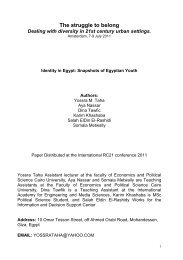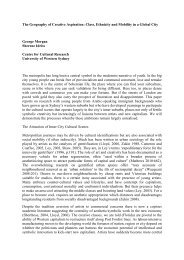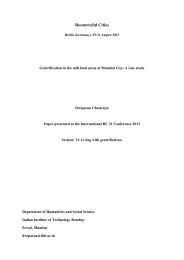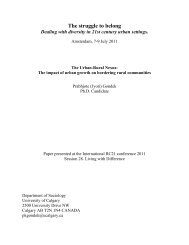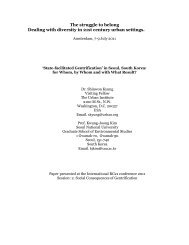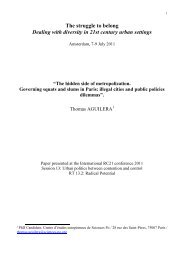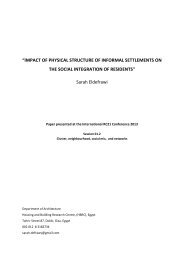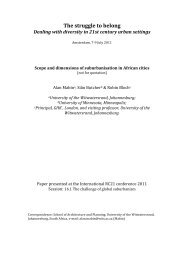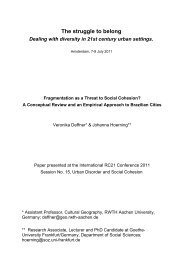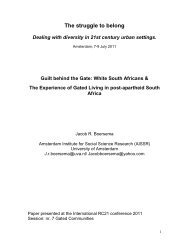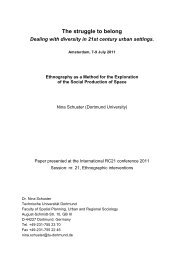Gentrification as a broad process of reurbanization - RC21 ORG ...
Gentrification as a broad process of reurbanization - RC21 ORG ...
Gentrification as a broad process of reurbanization - RC21 ORG ...
You also want an ePaper? Increase the reach of your titles
YUMPU automatically turns print PDFs into web optimized ePapers that Google loves.
Judit Veres CEU Budapest<br />
role and purview <strong>of</strong> the state, the economic and the civil society sphere very much<br />
complicating any neat analytical formulations and delimitations.<br />
Introduction<br />
For the p<strong>as</strong>t few decades one‘s retinal and emotional experience <strong>of</strong> cities h<strong>as</strong> shifted<br />
and attempts to account for this experience have been <strong>of</strong>ten expressed in terms <strong>of</strong> a<br />
structural shift from an industrial to postindustrial society, or/and <strong>as</strong> part <strong>of</strong> a shift<br />
from a city <strong>of</strong> production to a city <strong>of</strong> consumption. One <strong>of</strong> the most visible changes in<br />
the fabric <strong>of</strong> cities h<strong>as</strong> been the appearance <strong>of</strong> revamped post-industrial buildings,<br />
<strong>of</strong>ten transformed into urban cultural centres. These pockets <strong>of</strong> urban regeneration<br />
have mushroomed alongside many other urban developmental projects, presumably<br />
intricately related to them, and not le<strong>as</strong>t alongside and in conjunction with ruined and<br />
impoverished urban sites. Within a neoliberalizing urban political economy urban<br />
policies have prioritized economic development and not wealth distribution, area<br />
interventions and not universal policies, and individual projects and not a more<br />
encomp<strong>as</strong>sing planning context. This is best encapsulated by the penchant for<br />
‗emblematic projects‘ that ‗capture a segment <strong>of</strong> the city and turn it into the symbol <strong>of</strong><br />
the new restructured/revitalized metropolis‘ (Swygendouw et al., 2002; 562) with the<br />
state <strong>as</strong> one <strong>of</strong> the determining actors in the <strong>process</strong> (Swyngedouw, ibid.).<br />
Cities across the world, which have undertaken such urban regeneration projects, have<br />
been <strong>of</strong>ten presented <strong>as</strong> conferring on culture, and more particularly, on cultural<br />
centres, seemingly, a quite central role. If one thinks <strong>of</strong> Bilbao‘s Guggenheim, or<br />
Vienna‘s Museums Quartier, just to name these two very different instances, the<br />
question what these cultural sites have meant and done, beyond what the catch word<br />
‗urban regeneration through culture‘ might entail, in their immediate and larger urban<br />
context becomes a much more complicated issue to be understood and dissected.<br />
In my analysis I draw on the so-called ‗new urban sociology‘ that h<strong>as</strong> elaborated an<br />
explicitly spatialized and reflexively multi-scalar understanding <strong>of</strong> capitalist<br />
urbanization (Brenner 2004, Swyngedouw, Moulaert & Rodriguez 2005) the latter<br />
conceived <strong>as</strong> outcome <strong>of</strong> the uneven geographical development (Harvey 1990, 2005,<br />
2008, M<strong>as</strong>sey 1995, Smith 1996, 2002). The two major schools within radical urban<br />
3




